Building and Construction Assignment: Fire, Access, Evac
VerifiedAdded on 2020/05/11
|5
|905
|75
Homework Assignment
AI Summary
This construction assignment analyzes fire resistance, accessibility, and evacuation strategies according to the Australian National Construction Code. The assignment addresses fire source features and fire-resisting levels, determining the minimum fire resistance level based on concrete block wall thickness. It also examines accessibility and egress requirements for people with disabilities, including provisions for ramps, stairs, and lifts, ensuring compliance with building codes. Furthermore, the assignment details evacuation plans, specifying the number of exits required for basement and ground floor levels based on floor area and travel distances. The analysis references relevant clauses and subsections of the NCC to support the recommendations for building safety and compliance.
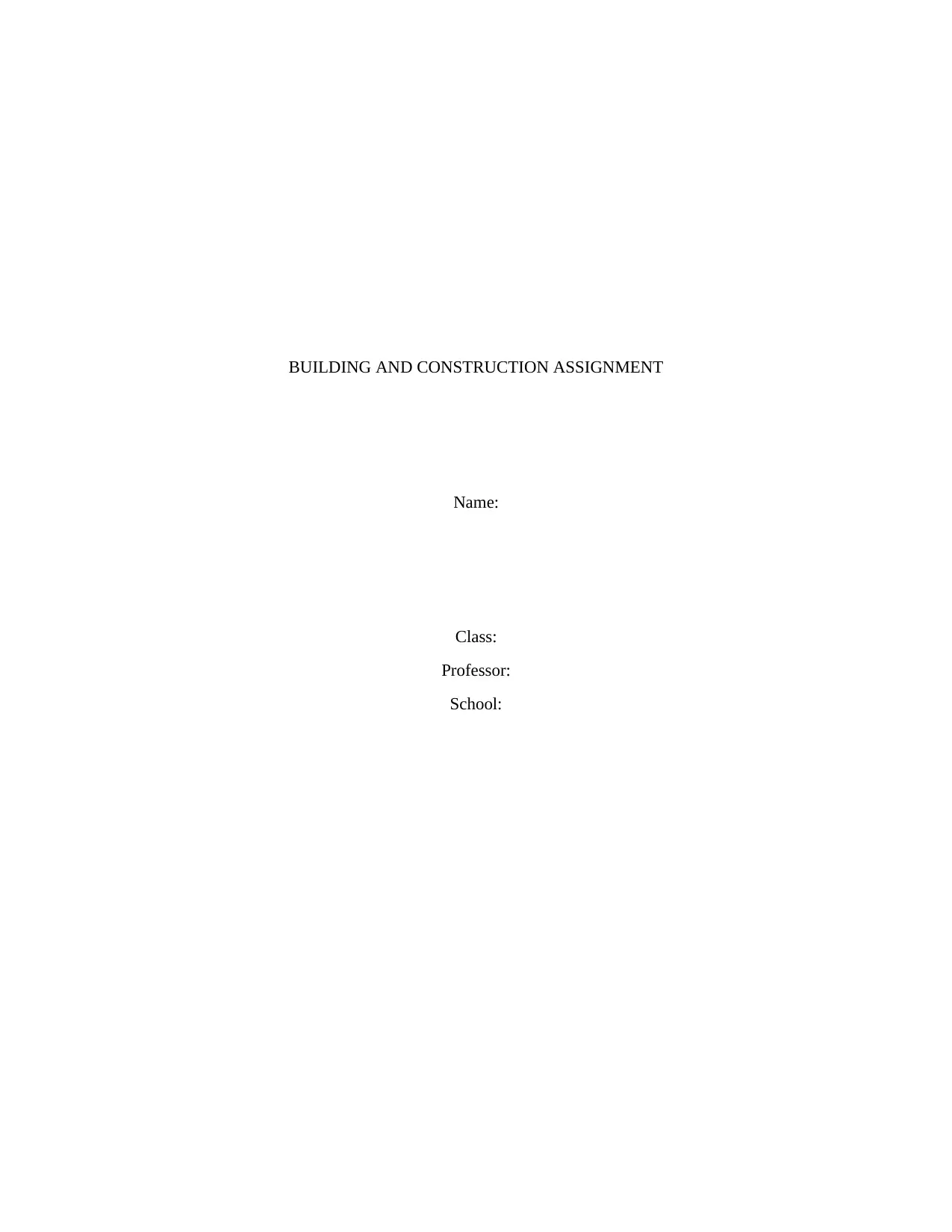
BUILDING AND CONSTRUCTION ASSIGNMENT
Name:
Class:
Professor:
School:
Name:
Class:
Professor:
School:
Paraphrase This Document
Need a fresh take? Get an instant paraphrase of this document with our AI Paraphraser
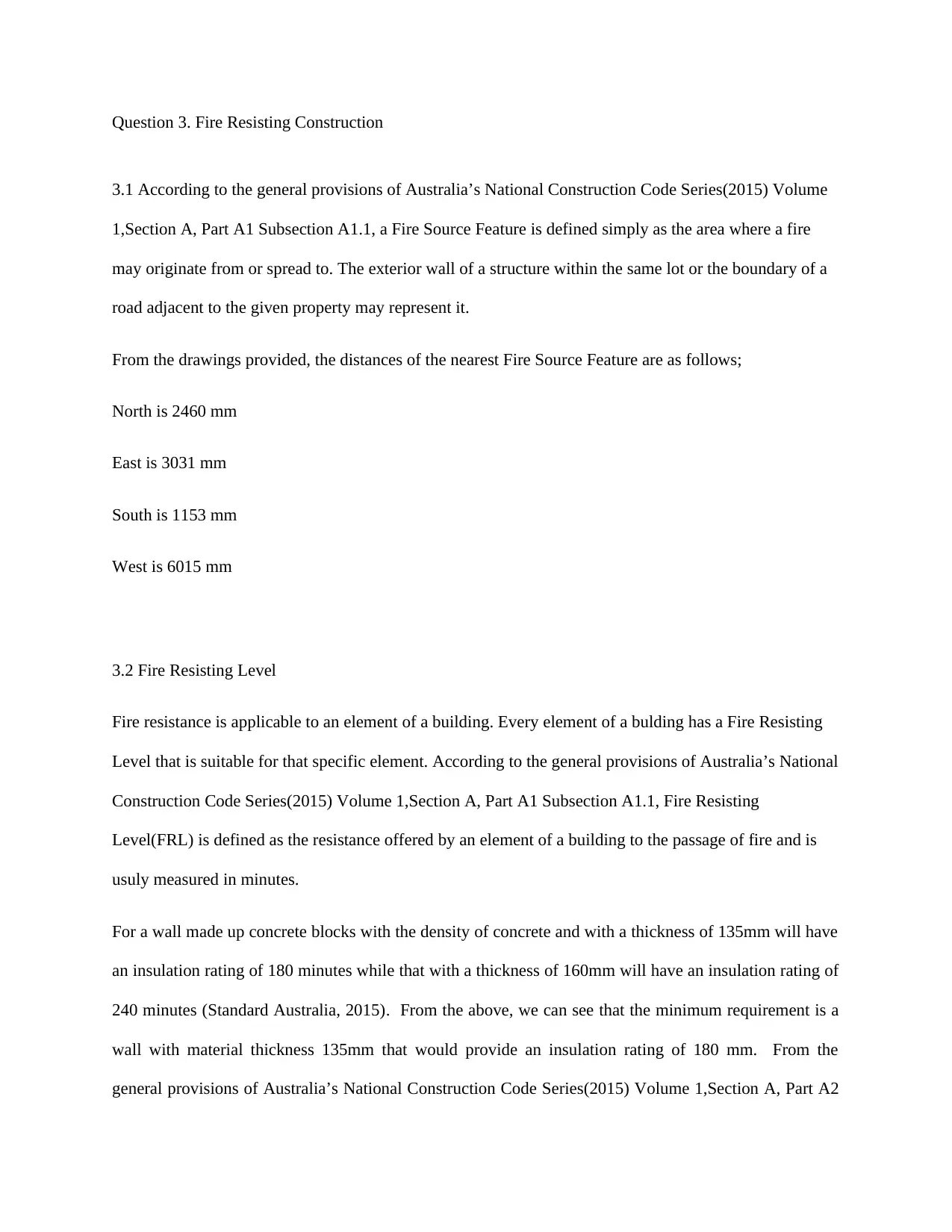
Question 3. Fire Resisting Construction
3.1 According to the general provisions of Australia’s National Construction Code Series(2015) Volume
1,Section A, Part A1 Subsection A1.1, a Fire Source Feature is defined simply as the area where a fire
may originate from or spread to. The exterior wall of a structure within the same lot or the boundary of a
road adjacent to the given property may represent it.
From the drawings provided, the distances of the nearest Fire Source Feature are as follows;
North is 2460 mm
East is 3031 mm
South is 1153 mm
West is 6015 mm
3.2 Fire Resisting Level
Fire resistance is applicable to an element of a building. Every element of a bulding has a Fire Resisting
Level that is suitable for that specific element. According to the general provisions of Australia’s National
Construction Code Series(2015) Volume 1,Section A, Part A1 Subsection A1.1, Fire Resisting
Level(FRL) is defined as the resistance offered by an element of a building to the passage of fire and is
usuly measured in minutes.
For a wall made up concrete blocks with the density of concrete and with a thickness of 135mm will have
an insulation rating of 180 minutes while that with a thickness of 160mm will have an insulation rating of
240 minutes (Standard Australia, 2015). From the above, we can see that the minimum requirement is a
wall with material thickness 135mm that would provide an insulation rating of 180 mm. From the
general provisions of Australia’s National Construction Code Series(2015) Volume 1,Section A, Part A2
3.1 According to the general provisions of Australia’s National Construction Code Series(2015) Volume
1,Section A, Part A1 Subsection A1.1, a Fire Source Feature is defined simply as the area where a fire
may originate from or spread to. The exterior wall of a structure within the same lot or the boundary of a
road adjacent to the given property may represent it.
From the drawings provided, the distances of the nearest Fire Source Feature are as follows;
North is 2460 mm
East is 3031 mm
South is 1153 mm
West is 6015 mm
3.2 Fire Resisting Level
Fire resistance is applicable to an element of a building. Every element of a bulding has a Fire Resisting
Level that is suitable for that specific element. According to the general provisions of Australia’s National
Construction Code Series(2015) Volume 1,Section A, Part A1 Subsection A1.1, Fire Resisting
Level(FRL) is defined as the resistance offered by an element of a building to the passage of fire and is
usuly measured in minutes.
For a wall made up concrete blocks with the density of concrete and with a thickness of 135mm will have
an insulation rating of 180 minutes while that with a thickness of 160mm will have an insulation rating of
240 minutes (Standard Australia, 2015). From the above, we can see that the minimum requirement is a
wall with material thickness 135mm that would provide an insulation rating of 180 mm. From the
general provisions of Australia’s National Construction Code Series(2015) Volume 1,Section A, Part A2
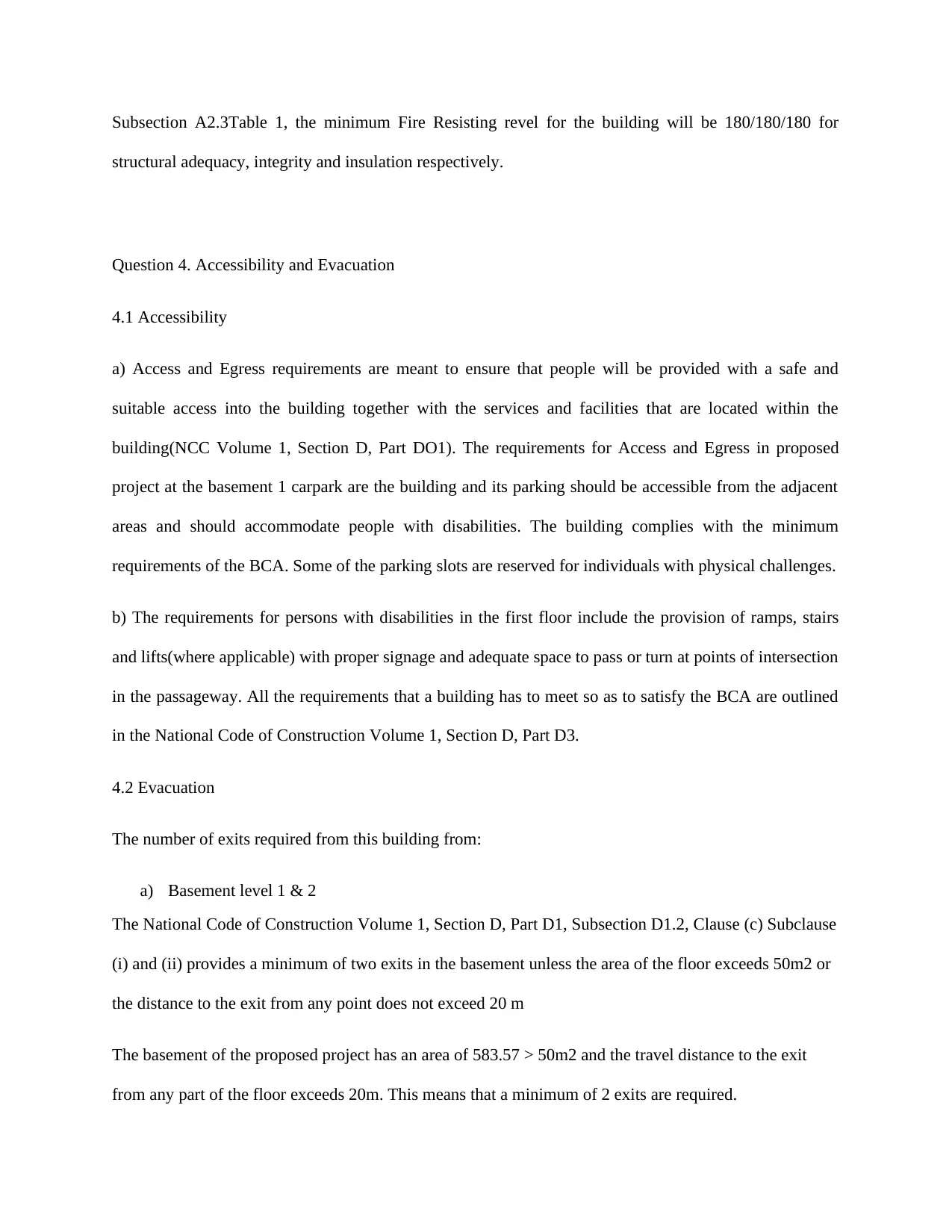
Subsection A2.3Table 1, the minimum Fire Resisting revel for the building will be 180/180/180 for
structural adequacy, integrity and insulation respectively.
Question 4. Accessibility and Evacuation
4.1 Accessibility
a) Access and Egress requirements are meant to ensure that people will be provided with a safe and
suitable access into the building together with the services and facilities that are located within the
building(NCC Volume 1, Section D, Part DO1). The requirements for Access and Egress in proposed
project at the basement 1 carpark are the building and its parking should be accessible from the adjacent
areas and should accommodate people with disabilities. The building complies with the minimum
requirements of the BCA. Some of the parking slots are reserved for individuals with physical challenges.
b) The requirements for persons with disabilities in the first floor include the provision of ramps, stairs
and lifts(where applicable) with proper signage and adequate space to pass or turn at points of intersection
in the passageway. All the requirements that a building has to meet so as to satisfy the BCA are outlined
in the National Code of Construction Volume 1, Section D, Part D3.
4.2 Evacuation
The number of exits required from this building from:
a) Basement level 1 & 2
The National Code of Construction Volume 1, Section D, Part D1, Subsection D1.2, Clause (c) Subclause
(i) and (ii) provides a minimum of two exits in the basement unless the area of the floor exceeds 50m2 or
the distance to the exit from any point does not exceed 20 m
The basement of the proposed project has an area of 583.57 > 50m2 and the travel distance to the exit
from any part of the floor exceeds 20m. This means that a minimum of 2 exits are required.
structural adequacy, integrity and insulation respectively.
Question 4. Accessibility and Evacuation
4.1 Accessibility
a) Access and Egress requirements are meant to ensure that people will be provided with a safe and
suitable access into the building together with the services and facilities that are located within the
building(NCC Volume 1, Section D, Part DO1). The requirements for Access and Egress in proposed
project at the basement 1 carpark are the building and its parking should be accessible from the adjacent
areas and should accommodate people with disabilities. The building complies with the minimum
requirements of the BCA. Some of the parking slots are reserved for individuals with physical challenges.
b) The requirements for persons with disabilities in the first floor include the provision of ramps, stairs
and lifts(where applicable) with proper signage and adequate space to pass or turn at points of intersection
in the passageway. All the requirements that a building has to meet so as to satisfy the BCA are outlined
in the National Code of Construction Volume 1, Section D, Part D3.
4.2 Evacuation
The number of exits required from this building from:
a) Basement level 1 & 2
The National Code of Construction Volume 1, Section D, Part D1, Subsection D1.2, Clause (c) Subclause
(i) and (ii) provides a minimum of two exits in the basement unless the area of the floor exceeds 50m2 or
the distance to the exit from any point does not exceed 20 m
The basement of the proposed project has an area of 583.57 > 50m2 and the travel distance to the exit
from any part of the floor exceeds 20m. This means that a minimum of 2 exits are required.
⊘ This is a preview!⊘
Do you want full access?
Subscribe today to unlock all pages.

Trusted by 1+ million students worldwide
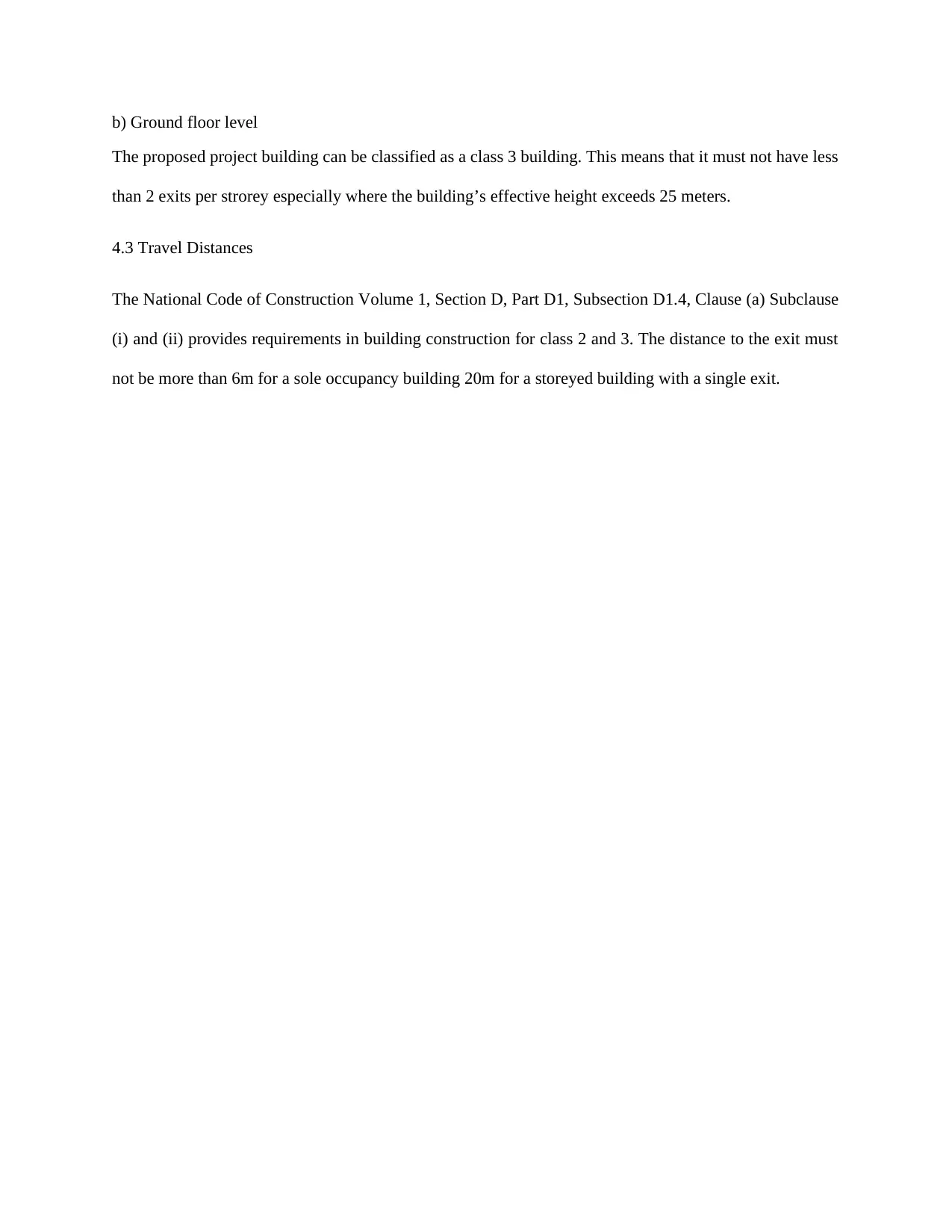
b) Ground floor level
The proposed project building can be classified as a class 3 building. This means that it must not have less
than 2 exits per strorey especially where the building’s effective height exceeds 25 meters.
4.3 Travel Distances
The National Code of Construction Volume 1, Section D, Part D1, Subsection D1.4, Clause (a) Subclause
(i) and (ii) provides requirements in building construction for class 2 and 3. The distance to the exit must
not be more than 6m for a sole occupancy building 20m for a storeyed building with a single exit.
The proposed project building can be classified as a class 3 building. This means that it must not have less
than 2 exits per strorey especially where the building’s effective height exceeds 25 meters.
4.3 Travel Distances
The National Code of Construction Volume 1, Section D, Part D1, Subsection D1.4, Clause (a) Subclause
(i) and (ii) provides requirements in building construction for class 2 and 3. The distance to the exit must
not be more than 6m for a sole occupancy building 20m for a storeyed building with a single exit.
Paraphrase This Document
Need a fresh take? Get an instant paraphrase of this document with our AI Paraphraser
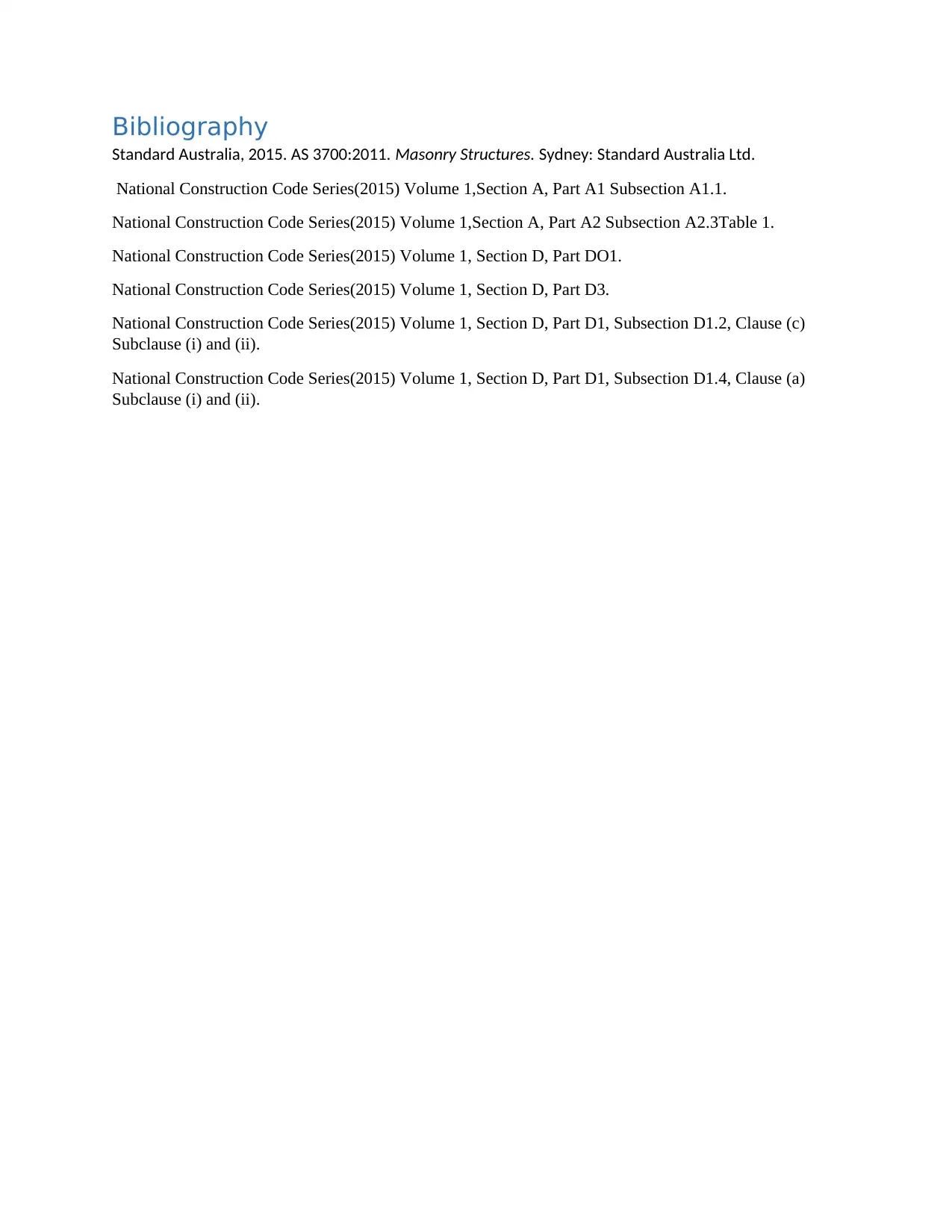
Bibliography
Standard Australia, 2015. AS 3700:2011. Masonry Structures. Sydney: Standard Australia Ltd.
National Construction Code Series(2015) Volume 1,Section A, Part A1 Subsection A1.1.
National Construction Code Series(2015) Volume 1,Section A, Part A2 Subsection A2.3Table 1.
National Construction Code Series(2015) Volume 1, Section D, Part DO1.
National Construction Code Series(2015) Volume 1, Section D, Part D3.
National Construction Code Series(2015) Volume 1, Section D, Part D1, Subsection D1.2, Clause (c)
Subclause (i) and (ii).
National Construction Code Series(2015) Volume 1, Section D, Part D1, Subsection D1.4, Clause (a)
Subclause (i) and (ii).
Standard Australia, 2015. AS 3700:2011. Masonry Structures. Sydney: Standard Australia Ltd.
National Construction Code Series(2015) Volume 1,Section A, Part A1 Subsection A1.1.
National Construction Code Series(2015) Volume 1,Section A, Part A2 Subsection A2.3Table 1.
National Construction Code Series(2015) Volume 1, Section D, Part DO1.
National Construction Code Series(2015) Volume 1, Section D, Part D3.
National Construction Code Series(2015) Volume 1, Section D, Part D1, Subsection D1.2, Clause (c)
Subclause (i) and (ii).
National Construction Code Series(2015) Volume 1, Section D, Part D1, Subsection D1.4, Clause (a)
Subclause (i) and (ii).
1 out of 5
Related Documents
Your All-in-One AI-Powered Toolkit for Academic Success.
+13062052269
info@desklib.com
Available 24*7 on WhatsApp / Email
![[object Object]](/_next/static/media/star-bottom.7253800d.svg)
Unlock your academic potential
Copyright © 2020–2025 A2Z Services. All Rights Reserved. Developed and managed by ZUCOL.





